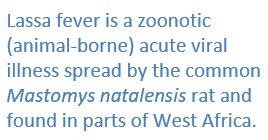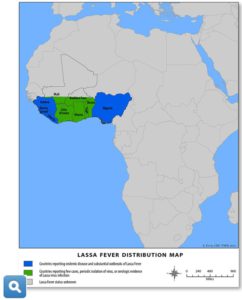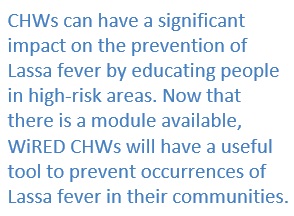By Allison Kozicharow; Edited by Staff
What is Lassa fever?
Lassa fever is a zoonotic (animal-borne) acute viral illness spread by the common Mastomys natalensis rat and found in parts of West Africa. Although most people’s cases are mild, one in five infections result in severe disease, which can impact organs such as the liver, spleen and kidneys and can lead to death.
 WiRED International, in response to a surge in cases in West Africa, now offers a Lassa Fever module, which describes the infection, its signs and symptoms, spread, diagnosis, treatment and prevention.
WiRED International, in response to a surge in cases in West Africa, now offers a Lassa Fever module, which describes the infection, its signs and symptoms, spread, diagnosis, treatment and prevention.
The key word is “prevention” because the illness is so difficult to diagnose early on. Community health workers (CHWs) can help their populations prevent the spread of Lassa fever by promoting good community hygiene.
 Effective prevention measures include:
Effective prevention measures include:
- Storing food stuff in rodent-proof containers;
- Disposing of garbage far from the home;
- Maintaining clean households and keeping cats to keep down the rat population;
- Telling people not to use these rodents as a food source; and
- Being careful and avoiding contact with blood and body fluids while tending to sick people.
Other prevention challenges include developing more rapid diagnostic tests and increasing the availability of the only known drug treatment, ribavirin.
 CHWs can have a significant impact on the prevention of Lassa fever by educating people in high-risk areas. Now that there is a module available, WiRED CHWs will have a useful tool to prevent occurrences of Lassa fever in their communities.
CHWs can have a significant impact on the prevention of Lassa fever by educating people in high-risk areas. Now that there is a module available, WiRED CHWs will have a useful tool to prevent occurrences of Lassa fever in their communities.
Note that WiRED will soon begin a CHW training program in Nigeria, where, in 2018, Lassa fever became a public health emergency. The disease has continued to climb since then, so the new CHWs will face a serious population health threat from the start of their deployment. WiRED’s Lassa Fever module, along with extensive classroom training in infectious diseases ,will enable the CHWs to address this community threat armed with solid, evidence-based information.
Quick facts about Lassa fever from WiRED’s module:
- The name “Lassa” comes from the town in Nigeria where the first cases occurred.
- The majority of infected persons have no symptoms, or the symptoms are mild and undiagnosed.
- The number of Lassa virus infections per year in West Africa is estimated at 100,000 to 300,000, with approximately 5,000 deaths (with some estimates are as high as 10,000).
 Mastomys rats are sometimes consumed as a food source, and infection may occur when rodents are caught and prepared.
Mastomys rats are sometimes consumed as a food source, and infection may occur when rodents are caught and prepared.- Person-to-person transmission is common in healthcare settings where personal protective equipment is not available or not used.
- Symptoms of severe Lassa fever include hemorrhaging (bleeding) in the gums, eyes, or nose; respiratory distress; repeated vomiting; facial swelling; pain in the chest, back, and abdomen; and shock.


